FOOTBALL
FAST FACTS 2
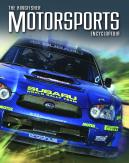 Motor racing has generated hundreds of great moments and races and even more fascinating facts. Below are a selection of surprising and stunning motorsports moments.
With his son, Michael, Mario Andretti formed the first ever, father and son front row of the grid in Champ Cars in 1986 at Phoenix. By the end of the 1980s, they had managed this feat a further nine times.
Motor racing has generated hundreds of great moments and races and even more fascinating facts. Below are a selection of surprising and stunning motorsports moments.
With his son, Michael, Mario Andretti formed the first ever, father and son front row of the grid in Champ Cars in 1986 at Phoenix. By the end of the 1980s, they had managed this feat a further nine times.
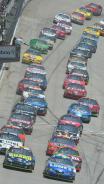 In 1990, A.J. Foyt’s Indy car brakes failed at the Road America circuit sending him hurtling down the track at almost 300km/h. The crash shattered his legs yet the following year, he qualified for the Indy 500, at the incredible age of 56.
In 1990, A.J. Foyt’s Indy car brakes failed at the Road America circuit sending him hurtling down the track at almost 300km/h. The crash shattered his legs yet the following year, he qualified for the Indy 500, at the incredible age of 56.
In 2004, Nascar events held 17 of the top 20 attended sports events in the USA. Approximately 40% of those who attended were women.
Situated in the US state of North Carolina, home to many of the Nascar teams, the car-crazy town of Concord has almost 40 museums devoted to motor sport and history.
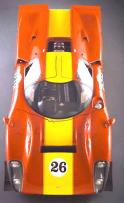 58,202 cars of visitors were parked at the 2003 Goodwood Festival of Speed. If they were lined up bumper to bumper, the traffic jam would be 232.66km (144.6 miles) long.
58,202 cars of visitors were parked at the 2003 Goodwood Festival of Speed. If they were lined up bumper to bumper, the traffic jam would be 232.66km (144.6 miles) long.
Nigel Mansell endured far more crashes and injuries during his career than most racing drivers. One of the most unusual was on his Grand Prix debut at the 1980 Austrian GP when a fuel leak in the cockpit left him with first and second degree burns on his bottom.
In 1896, the first motor insurance policy was issued by the General Accident Co in Britain. It excluded damage caused by frightened horses.
 In 1958, Juan Fangio was kidnapped at gunpoint from his hotel the night before a race in Cuba. The kidnappers, part of Fidel Castro’s rebel force, held him for 26 hours before releasing him unharmed. Fangio’s room, 810, at the Hotel Lincoln, is preserved as it was and is open to tourists.
In 1958, Juan Fangio was kidnapped at gunpoint from his hotel the night before a race in Cuba. The kidnappers, part of Fidel Castro’s rebel force, held him for 26 hours before releasing him unharmed. Fangio’s room, 810, at the Hotel Lincoln, is preserved as it was and is open to tourists.
The 1958 season also saw Mike Hawthorn leading at the French Grand Prix which was Juan Fangio’s last race. As a mark of respect, Hawthorn slowed so as not to lap the great Argentinean, before crossing the line himself to win.
In 1967 at Spa, Jackie Stewart was forced to hold his car in gear for much of the race. He had to drive one-handed round the circuit yet managed to come in second behind Dan Gurney.
![]()
INSIDE GUIDE - The Racing Line
The racing line is the ideal route around the track taken by drivers. Midway through a race, it can often be seen on the track by the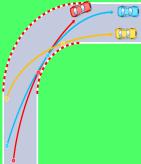 darker areas of the track left by the tyre trails of a heavy stream of traffic. A good racing line through a 90 degree corner (in blue) into a right-hand sees the turn start from the outside of the track clip the inside point of the turn at its apex and power away to the outer portion of the track for a fast exit. Too early a turn-in (in red) can result when a racer approaches a turn at too great a speed. It can lead to problems in negotiating the turn safely and may see the driver crash out or have to brake hard during the turn. This can lead to a far slower exit speed and time lost.
Cautious racers may take a late line (in yellow) turning into the corner sharply but at a slow speed, losing much speed.
darker areas of the track left by the tyre trails of a heavy stream of traffic. A good racing line through a 90 degree corner (in blue) into a right-hand sees the turn start from the outside of the track clip the inside point of the turn at its apex and power away to the outer portion of the track for a fast exit. Too early a turn-in (in red) can result when a racer approaches a turn at too great a speed. It can lead to problems in negotiating the turn safely and may see the driver crash out or have to brake hard during the turn. This can lead to a far slower exit speed and time lost.
Cautious racers may take a late line (in yellow) turning into the corner sharply but at a slow speed, losing much speed.
FAST FACTS
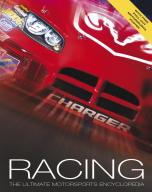 A NASCAR traveling at its top speed of 320km/h covers the length of a football field every second.
An unsentimental man, Formula One champion, Niki Lauda gave away many of his race trophies to a local garage owner. In return, Lauda’s cars received free car washes!
Wayne Rainey won the 500cc World Championship in 1992 despite having a pre-season crash which resulted in him having his little finger of his left hand amputated.
A NASCAR traveling at its top speed of 320km/h covers the length of a football field every second.
An unsentimental man, Formula One champion, Niki Lauda gave away many of his race trophies to a local garage owner. In return, Lauda’s cars received free car washes!
Wayne Rainey won the 500cc World Championship in 1992 despite having a pre-season crash which resulted in him having his little finger of his left hand amputated.
 Rally ace, Carlos Sainz endured heartbreak in the 1998 World Rally Championship. His car broke down just 200 metres from the finish line of the final stage of the Rally of Great Britain, handing the Championship crown to Tommi Makkinen.
In 2004, film actor Paul Newman became the oldest competitor to take part in the legendarily tough Baja 1000 offroad race. He was 80 years old!
Rally ace, Carlos Sainz endured heartbreak in the 1998 World Rally Championship. His car broke down just 200 metres from the finish line of the final stage of the Rally of Great Britain, handing the Championship crown to Tommi Makkinen.
In 2004, film actor Paul Newman became the oldest competitor to take part in the legendarily tough Baja 1000 offroad race. He was 80 years old!
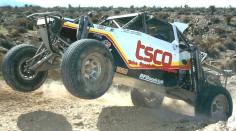 Early safety features in NASCARs were not that good. In 1952, Tim Flock was disqualified in one race because his roll cage – the frame inside the car that protects the driver if he crashes – was made of wood.
Motocross legend, Malcolm Smith’s first bike was a Lambretta scooter. He converted the smooth tyres into motocross ‘knobbies’ by collecting old football studs/cleats and screwing them into the tyres.
Early safety features in NASCARs were not that good. In 1952, Tim Flock was disqualified in one race because his roll cage – the frame inside the car that protects the driver if he crashes – was made of wood.
Motocross legend, Malcolm Smith’s first bike was a Lambretta scooter. He converted the smooth tyres into motocross ‘knobbies’ by collecting old football studs/cleats and screwing them into the tyres.
 During the 1899 Tour de France race, leading driver of the day, Fernand Charron lost all forward gears on his Panhard near Le Mans. He drove approximately 40km backwards to complete the stage!
At the 1930 Targa Florio, Achille Varzi’s car was set alight by his onboard mechanic trying to refuel as they kept racing. Varzi was unwilling to stop and lose so his mechanic fought the fire with his seat cushion as they crossed the line and won.
From 1961 to 2000, Mario Andretti competed in 879 races in a vast variety of classes winning 111 events and securing 109 poles. He is the only driver to have won major races in five different decades.
During the 1899 Tour de France race, leading driver of the day, Fernand Charron lost all forward gears on his Panhard near Le Mans. He drove approximately 40km backwards to complete the stage!
At the 1930 Targa Florio, Achille Varzi’s car was set alight by his onboard mechanic trying to refuel as they kept racing. Varzi was unwilling to stop and lose so his mechanic fought the fire with his seat cushion as they crossed the line and won.
From 1961 to 2000, Mario Andretti competed in 879 races in a vast variety of classes winning 111 events and securing 109 poles. He is the only driver to have won major races in five different decades.
